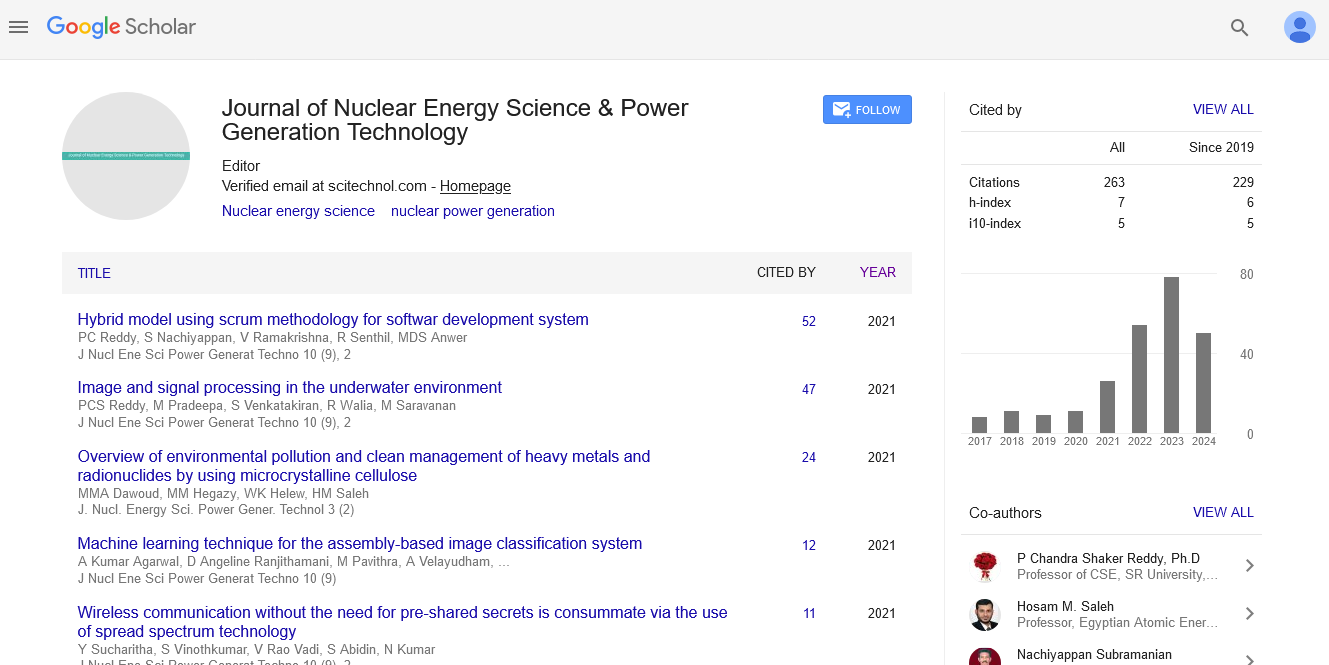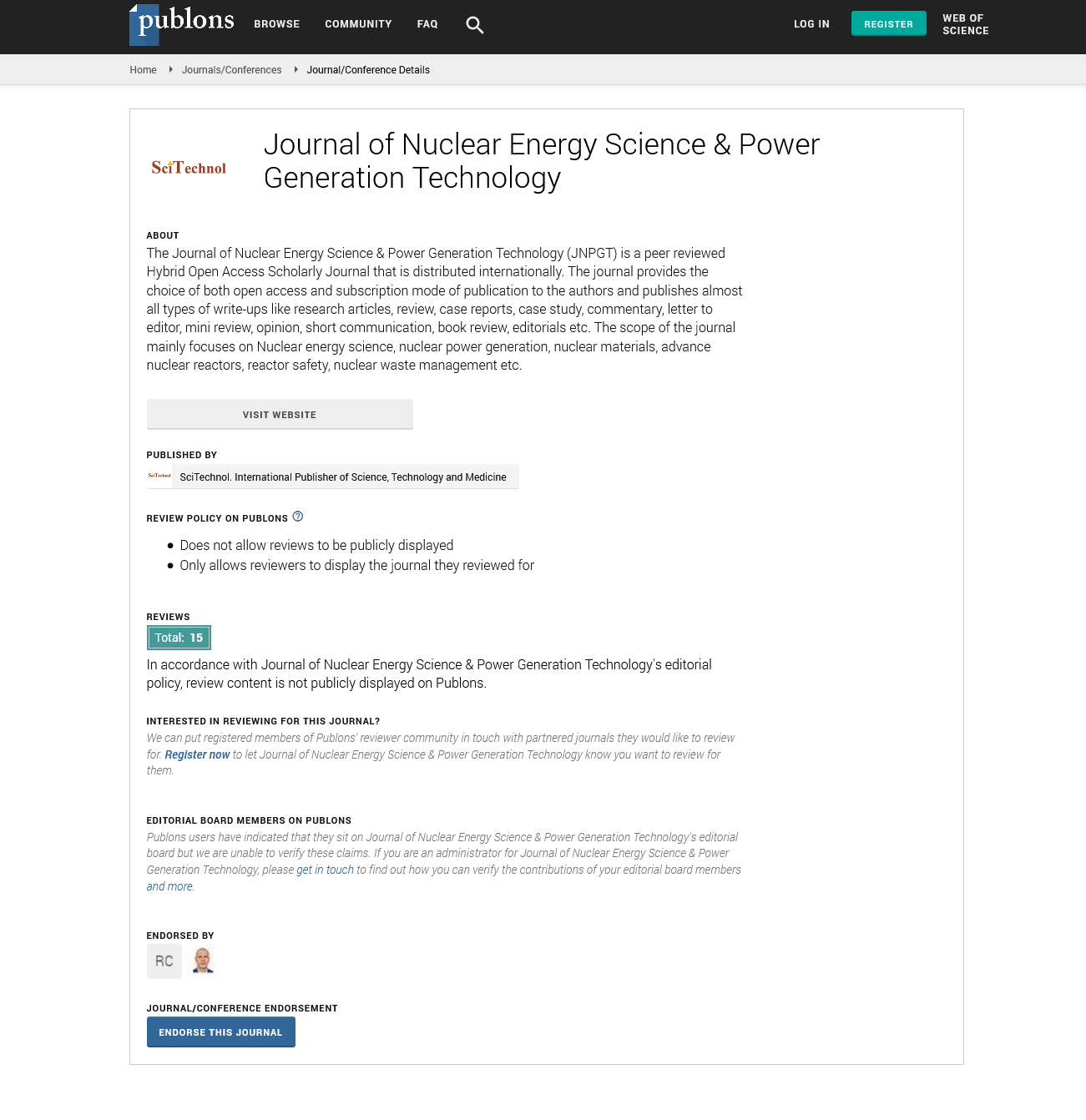Short Communication, J Nucl Ene Sci Power Generat Technol Vol: 13 Issue: 5
Enhancing Safety with Thorium as a Fuel for Sustainable Nuclear Power
Udaiy Rao*
1Department of Energy Science and Engineering, Indian Institute of Technology Bombay, Mumbai, India
*Corresponding Author: Udaiy Rao,
Department of Energy Science and
Engineering, Indian Institute of Technology Bombay, Mumbai, India
E-mail: udaiy_rao579@iit.co.in
Received date: 26 August, 2024, Manuscript No. JNPGT-24-150419;
Editor assigned date: 28 August, 2024, PreQC No. JNPGT-24-150419 (PQ);
Reviewed date: 11 September, 2024, QC No. JNPGT-24-150419;
Revised date: 18 September, 2024, Manuscript No. JNPGT-24-150419 (R);
Published date: 25 September, 2024, DOI: 10.4172/2325-9809.1000422.
Citation: Rao U (2024) Enhancing Safety with Thorium as a Fuel for Sustainable Nuclear Power. J Nucl Ene Sci Power Generat Technol 13:5.
Description
Thorium has emerged as a promising alternative to uranium in the field of nuclear power generation. As global energy demands increase and concerns about the safety, waste management and sustainability of traditional nuclear power rise, thorium-based nuclear reactors provide a potentially safer, more efficient and sustainable solution [1]. Thorium, a naturally occurring radioactive element, is abundant in the Earth's crust and presents an opportunity to change the way to generate clean and reliable nuclear energy. Thorium is a rich material that can be transformed into fissile material through a process called neutron absorption. Unlike uranium-235, which is directly fissile, thorium cannot be used on its own to sustain a nuclear chain reaction.
Instead, when thorium absorbs a neutron, it converts into uranium-233, which can then undergo fission to release energy. The key advantage of thorium is its abundance thorium is about three to four times more common than uranium in the Earth's crust, making it a highly attractive resource for long-term energy security [2-4]. Countries like India and China have large thorium reserves, making it geopolitically appealing for nations aiming to reduce dependence on imported energy resources. There are several designs for thorium reactors, but the most notable is the Liquid Fluoride Thorium Reactor (LFTR). This type of reactor uses molten salt as both a fuel and a coolant which helps to operate the reactor at much higher temperatures than traditional water-cooled reactors, improving efficiency.
Basic principle of a thorium reactor
Thorium is introduced into the reactor: As thorium-232 absorbs neutrons, it gradually converts into uranium-233.
Fission of uranium-233: Once uranium-233 is formed, it can undergo fission, releasing a significant amount of energy [5].
Energy generation: The energy from the fission process is used to heat a working fluid (such as molten salt), which then initiate turbines to generate electricity.
Thorium is much more abundant than uranium, and its high availability ensures that it can provide a stable and long-term fuel supply for future generations [6,7]. This abundance makes thorium reactors economically viable in the long run, providing a nearly inexhaustible source of energy. One of the significant concerns with traditional uranium-based reactors is the long-lived radioactive waste they produce. Thorium reactors generate far less long-lived radioactive waste and the waste they do produce has a shorter half-life compared to waste from uranium reactors [8]. This reduces the burden of long-term waste storage and environmental contamination. Thorium reactors provide natural safety features that make them less susceptible to meltdowns and other catastrophic failures.
In LFTR designs, the reactor operates at atmospheric pressure, which eliminates the risk of a pressurized explosion. Additionally, in the event of a malfunction, the molten salt can drain into a passive cooling tank, shutting down the reactor safely without human intervention. Thorium reactors are also proliferation-resistant, as they do not produce large amounts of plutonium, which is a key material for nuclear weapons. Thorium reactors can operate at higher temperatures, leading to more efficient energy generation. Additionally, thorium’s ability to breed uranium-233 makes it a more efficient use of nuclear fuel than uranium-235, potentially allowing thorium reactors to extract more energy from a given quantity of fuel [9,10].
Conclusion
Thorium has the potential to play an important role in the future of sustainable energy. As the world search to reduce carbon emissions and transition away from fossil fuels, nuclear energy will be an essential part of the energy mix, and thorium reactors provide a safer, more efficient and environmentally friendly alternative to uraniumbased nuclear power. Countries like India, with their vast thorium reserves, are leading the way in developing thorium-based technologies, and as global energy needs grow, investment in thorium reactors may accelerate. In conclusion, power generation using thorium represents a favorable way toward a more sustainable and safer nuclear future. With continued research and development, thorium could become a foundation of global clean energy strategies, helping to meet the growing demand for electricity while minimizing environmental impact.
References
- Humphrey UE, Khandaker MU (2018) Viability of thorium-based nuclear fuel cycle for the next generation nuclear reactor: Issues and prospects. Renew Sustain Energy Rev 97:259-275.
- Banerjee S, Gupta HP, Bhardwaj SA (2016) Nuclear power from thorium: Different options. Curr Sci 25:1607-1623.
- Emblemsvag J (2022) Safe, clean, proliferation resistant and cost-effective thorium-based molten salt reactors for sustainable development. Int J Sustain Energy 41(6):514-537.
- Kroger W, Sornette D, Ayoub A (2020) Towards safer and more sustainable ways for exploiting nuclear power. World J Nucl Sci Technol 10(3):91-115.
- Rehm TE (2023) Advanced nuclear energy: The safest and most renewable clean energy. Curr Opin Chem Eng 39:100878.
- Lombardi C, Luzzi L, Padovani E, Vettraino F (2008) Thoria and inert matrix fuels for a sustainable nuclear power. Prog Nucl Energy 50(8):944-953.
- Vijayan PK, Shivakumar V, Basu S, Sinha RK (2017) Role of thorium in the Indian nuclear power programme. Prog Nucl Energy 101:43-52.
- Kamei T, Hakami S (2011) Evaluation of implementation of thorium fuel cycle with LWR and MSR. Prog Nucl Energy 53(7):820-824.
- Manchanda VK (2023) Thorium as an abundant source of nuclear energy and challenges in separation science. Radiochimica Acta 111(4):243-263.
- Serfontein DE, Mulder EJ (2014) Thorium-based fuel cycles: Reassessment of fuel economics and proliferation risk. Nucl Eng Des 271:106-113.
 Spanish
Spanish  Chinese
Chinese  Russian
Russian  German
German  French
French  Japanese
Japanese  Portuguese
Portuguese  Hindi
Hindi 

